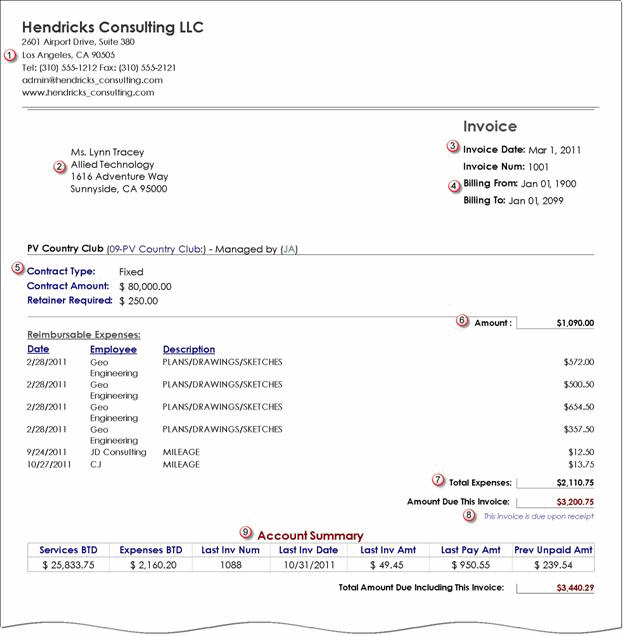
Progressive flat fee billing occurs when a client is billed a portion of the total contract amount over a few months. Depending on the circumstances, the billed amount can be the same (fixed) or vary in each billing cycle.
When the project contract or company policy defines a different billing amount, use a billing schedule to define billing records. You can create future billing records in it, adding or editing them later. This is also useful for milestone billing.
Using the billing record’s Reminder Date in the schedule, Web Suite knows when to remind you to process an invoice. The Billing Schedule allows you to enter a bill amount or calculate it as a percent of the contract amount. In addition, you can apply a percentage of the project’s retainer to the billing records. Another option is to include expenses in the bill amount or bill them in addition to that amount. Similarly, you can bill or ‘absorb’ extra time and expense (over-contract amounts). Web Suite also enables you to add a note to carry to the invoice.
Fixed Fee Invoice
Fixed fee invoice is also called the company’s ‘single service fee invoice’. From the sample below, you can gain an understanding of how the billing process requires input from different sources and how the entire information fits together.
Web Suite adds a ‘Draft’ watermark when you choose the Draft option on the Billing Review screen. The watermark disappears when you finalize it in Invoice Review screen. The ‘Paid’ watermark prints when the invoice finishes processing.

 Name
and address carry from the Company screen.
Name
and address carry from the Company screen.
 The
recipient’s name and address carry from (a) the main client contact and
client address, or (b) the project contact address (prints only if you
mark ‘Send Invoice to Contact’).
The
recipient’s name and address carry from (a) the main client contact and
client address, or (b) the project contact address (prints only if you
mark ‘Send Invoice to Contact’).
 Invoice
Date defaults to the system date. Companies usually change the invoice
to a future date to allow for printing and mailing. Aging begins on this
date.
Invoice
Date defaults to the system date. Companies usually change the invoice
to a future date to allow for printing and mailing. Aging begins on this
date.
Web Suite assigns the next available invoice number on checking the Bill
box in the Billing Review screen. In this case, a draft invoice number
prints in angle brackets.
 The
date range carries from the Billing Review screen. The range determines
what unbilled, approved time and expenses (work-in-progress) to include
in the billing record. As you can see, the date range covers any period
you want.
The
date range carries from the Billing Review screen. The range determines
what unbilled, approved time and expenses (work-in-progress) to include
in the billing record. As you can see, the date range covers any period
you want.
 Note
that the contract type is Fixed. The company chose to bill by time (rather
than by percent complete or with a billing schedule).
Note
that the contract type is Fixed. The company chose to bill by time (rather
than by percent complete or with a billing schedule).
 The
Amount (Net Bill on Billing Review) is Service Amount (Billable on Billing
Review) less adjustments such as applied discounts, write-up/down,
applied retainer, etc. Service Amount is the billable value of the approved
time entries in the specified date range (see
The
Amount (Net Bill on Billing Review) is Service Amount (Billable on Billing
Review) less adjustments such as applied discounts, write-up/down,
applied retainer, etc. Service Amount is the billable value of the approved
time entries in the specified date range (see  ), including
any taxes on individual entries (Tax 1, 2 or 3 of Activity or in the service
fee schedule assigned to the project).
), including
any taxes on individual entries (Tax 1, 2 or 3 of Activity or in the service
fee schedule assigned to the project).
 Approved
expenses within the date range defined on the Billing Review screen, which
includes taxes on individual entries.
Approved
expenses within the date range defined on the Billing Review screen, which
includes taxes on individual entries.
You may or may not apply GST to your invoices. Typically, GST equals the
calculated Main Service Tax on total labor billed plus calculated
Main Expense Tax on total expenses billed. You can define MST and MET
percentages on the Company screen, and as needed, change the rates in
Client and Project profiles.
 Payment
terms for the invoice. Web Suite first looks at the terms specified in
the Project profile, else the Client profile. If neither profile contains
it, Web Suite prints the default payment term (‘This invoice is due upon
receipt’).
Payment
terms for the invoice. Web Suite first looks at the terms specified in
the Project profile, else the Client profile. If neither profile contains
it, Web Suite prints the default payment term (‘This invoice is due upon
receipt’).
 Account
Summary includes Accounts Receivable (A/R) information – past invoices,
payments and amount unpaid. Other invoice formats include retainer paid,
balance information or aging summary.
Account
Summary includes Accounts Receivable (A/R) information – past invoices,
payments and amount unpaid. Other invoice formats include retainer paid,
balance information or aging summary.
 Web Suite supports two memos
per invoice. In most invoice formats, the first appears near the top of
the invoice and the second near the bottom.
Web Suite supports two memos
per invoice. In most invoice formats, the first appears near the top of
the invoice and the second near the bottom.